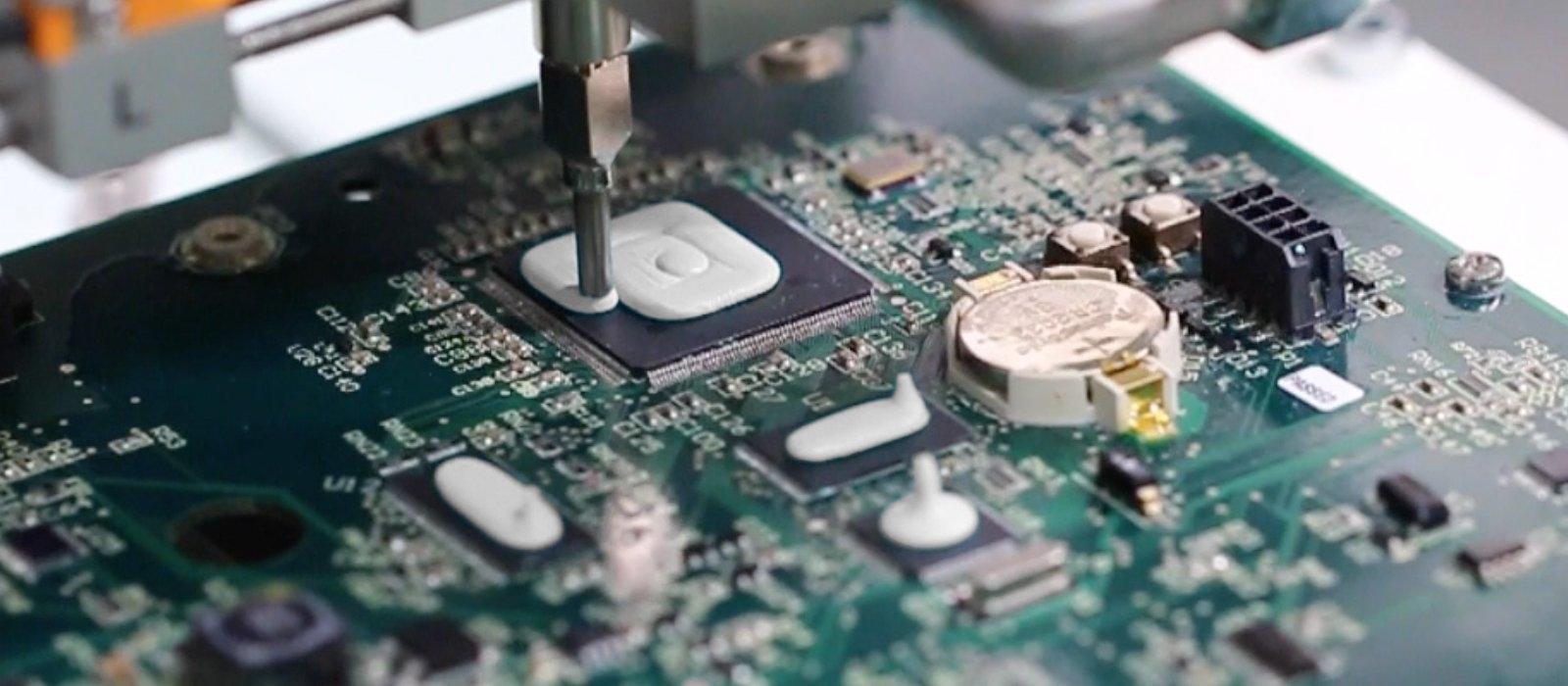Thermal Management for EV Battery and Electronics Manufacturing
Whether it’s assembling electric vehicle (EV) batteries and electronic products, or miniaturizing printed circuit boards (PCBs), reliable thermal management remains crucial to longevity, efficiency and safety.
Now more than ever before, electric vehicle (EV) batteries and electronics must last longer, perform faster, and guarantee safety. Meeting those ever-increasing demands requires reliable thermal management.
What is Thermal Management?
The more power and capacity you pack into a small space – like a battery cell or a circuit board – the more heat it generates. Thermal management safely dissipates excessive heat away from a battery or electronic component so that it functions properly and does not combust.
- In EV batteries, this usually involves surrounding or encapsulating the part in thermal interface material (TIM), also known as gap filler.
- In electronics, TIM typically is dispensed directly onto the surface of electronic components.
Why is Thermal Management Important?
Temperature plays a huge role in the longevity, efficiency and safety of a battery cell or electronic component.
- If the temperature is too low, power, capacity or performance can decrease.
- If the temperature is too high, degradation can occur, reducing the product’s life cycle. Too much heat also can cause safety risks that can have catastrophic consequences.
Keeping the temperature constant and evenly distributed is advised. Yet, reliable thermal management challenges manufacturers because excessive heat occurs for so many different reasons.
Therefore, batteries and electronics must be designed with thermal management systems that prevent overheating and safely guide the heat away from critical components.
What Causes Excessive Heat in Batteries and Electronics?
Electric vehicle (EV) batteries and electronics can overheat – sometimes causing thermal events – because of overcharging, rapid discharging, or environmental factors. Ongoing optimization most often puts thermal management at risk.
- To improve EV battery performance and reduce weight, battery cells have a higher energy density that results in more heat generated inside a smaller space.
- To increase speed and decrease size, electronic components are miniaturized and functions are integrated, so that more can fit on printed circuit boards (PCBs) and confined spaces. The more compact and powerful PCBs become, the more heat they create.
Transferring Heat Away from Batteries
Keeping Circuit Boards from Getting Overheated
A printed circuit board (PCB) can consist of many components, and together, they generate a lot of heat. The top and bottom surfaces are where microchips, capacitors, connectors, resistors, and other components are mounted.
Heat can accumulate in the tiniest air gaps within the electronic device, causing the circuit board to overheat and stop working. That’s where thermal interface material comes in.

TIM fills in those air gaps, so that the heat transfers quickly from the heat generating components to the heat dissipation components. This keeps the electronic device within an optimal temperature range, so that it works and lasts longer.
Why are TIMs Tough on Manufacturers?
Thermal interface materials are very thick and pasty. TIMs also contain highly abrasive particles that can be as tough as diamonds. This combination quickly wears out and damages traditional industrial dispense systems. With frequent fixing or replacement of pumps, shafts and seals comes a lot of production downtime and maintenance costs.
Correctly mixing and applying thermally conductive materials also can be challenging. The pastes are often two component materials that necessitate precise, on-ratio dispense. It is crucial to dispense appropriate and even amounts to avoid air gaps or overflow.
Thermal Management Solutions for Battery and Electronics Manufacturing
To keep battery and electronic assembly lines in production with thermal interface materials (TIMs), they need dispense systems with these requirements:
- abrasive resistant components that withstand the harshest conditions
- accurate and repeatable dispense that properly distributes material for low or high flow applications
- data downloads - process data and job logs – that identify issues before they cause downtime
- easy integration into automation equipment
Contact Thermal Management Experts
At Graco, we have extensive experience working with highly viscous and highly abrasive materials. In partnership with major material manufacturers, we design and support systems that provide precision dispense and withstand the most demanding applications.
Related Materials and Research
Thermal Interface Materials
Thermal interface material (TIM) dissipates heat away from components, thus improving their speed, longevity, and manufacturability. Batteries and electronics especially need heat dissipation so that they perform as consumers expect.
Extreme Material Abrasiveness? Problem Solved with Elite
Some thermal interface materials (TIMs) are so abrasive, it’s like pumping diamond dust or liquid sandpaper. Explore why and how we developed Elite™, the longest-lasting pump construction for abrasive material dispense.
Extreme Material Abrasiveness? Problem Solved with Elite
Some thermal interface materials (TIMs) are so abrasive, it’s like pumping diamond dust or liquid sandpaper. Explore why and how we developed Elite™, the longest-lasting pump construction for abrasive material dispense.
Solutions for...
Electronics
Improve electronics manufacturing productivity, compete more effectively and maintain an edge with solutions in bonding, sealing, thermal management, and more.
EV Battery
Explore sealing, bonding, and thermal management solutions for electric vehicle (EV) and hybrid vehicle (HV) battery pack and module assembly.







